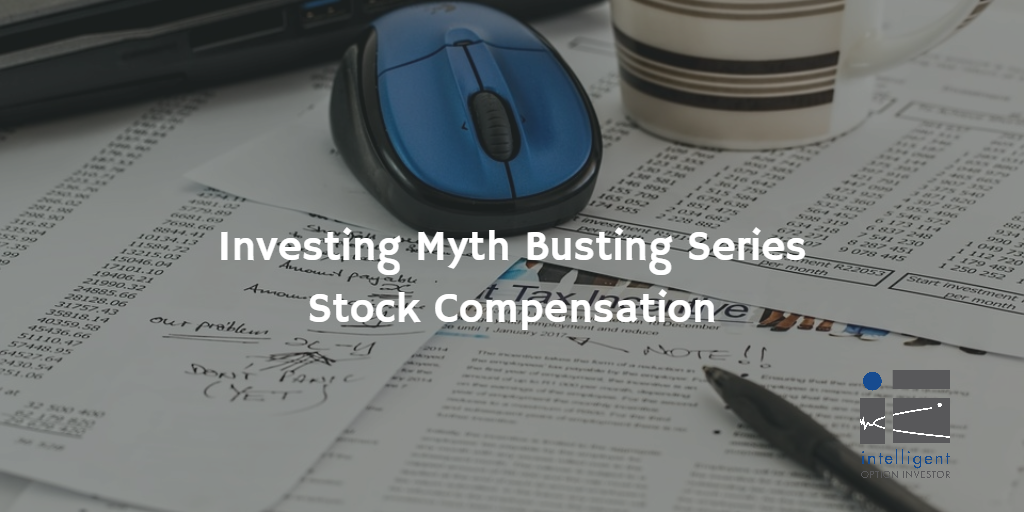
If you were running a small business with a partner and your partner did to you what management teams routinely do to their shareholders, you would probably file a suit. It’s a strange fact that when investing in publicly-traded stocks, people start measuring success using a different yardstick than that of common sense.
Today’s myth busting article looks at several related myths regarding stock compensation:
- Stock compensation “aligns” employees’ interests with stock owners.
- Stock buybacks “create value” for shareholders.
- Stock compensation doesn’t have a cash cost to owners.
Stock Compensation Aligns Interests
Financial theorists reason that if a shareholder owns shares and a CEO owns shares, the latter’s interests are aligned with the former’s.
To the extent that both an investor and a shareholding CEO wants the company to succeed while they both hold the shares, I guess this argument can be said to be true. However, there is one very crucial difference: namely, the investor has to purchase those owned shares with the sweat from his or her own brow, whereas the CEO (and other managers and employees) are presented the shares in the same way that a high roller might be comped chips at a casino.
If you walked into a casino and someone handed you $50,000 worth of chips and told you to sit down at a table and have a good time, what would you do?
Now imagine that you were a CEO given tens of millions of dollars worth of stock, what kinds of decisions would you make? You might make an expensive acquisition to boost your new company’s revenues to make you look like a business genius on paper. You might figure out a tricky way to make profits look so much better than they are. Or, maybe you’ll just ride the gravy train and pick a good time to retire.
Stock compensation does not “align interests” – it diverts the company’s profits to employees rather than to shareholders. This would be easily visible if shareholders realized the extent to which their interests were being diluted.
Thanks to massive stock buyback programs, though, they never do.
Stock Buybacks Create Value
The logic is beautiful. Every stock has an intrinsic value. If a management team buys back stock at below its intrinsic value, it is using the owners’ capital wisely, so is “creating value.”
Terrific! If you’re a manager, you no longer need to innovate or cut costs or invest in new technologies wisely to create value. All you need to do is buy your own company’s stock. The story gets even better!
- You get to use profits that would have otherwise flowed to shareholders to buy back the stock.
- Every ten shares you buy back obfuscates the fact that you’ve just issued three to yourself (to properly align your interests with owners).
- The more you buy back, the lower your share count is, and the higher your earnings per share is.
Share buybacks concentrate value, they do not create it.
If there are no better investment alternatives, a company’s buying back stock concentrates ownership in the remaining shareholders’ hands, and that is a good thing. However, if the company is issuing half a billion dollars or more in stock comp per year to its employees (Wal-Mart, Apple, Oracle, etc., etc.), the increased ownership concentration isn’t nearly as good as what you might expect when you listen to the announcement (with great fanfare) about the Board’s approval of the buyback plan.
Stock Compensation is Free to Owners
Because companies buy back so much stock, investors don’t notice that they are being diluted, so they might be tempted to think that stock awards to managers and employees doesn’t have a cash cost at all.
The short story is that stock compensation schemes do have a real cash cost to owners. Period.
A recent article in the New York Times made an attempt to calculate these costs, but they got it wrong and double counted. (To cut the New York Times a little slack, the article was based on some research by an East Coast hedge fund named Wintergreen Advisors, who should have known better, in my opinion.)
At IOI, we know we can’t count the costs of stock compensation exactly, but we can get a pretty good and consistent estimate by working through the following steps:
- Find out how many shares a company issued over a given period. (This information is available on a financial statement called the Statement of Shareholder Equity.)
- Find out how much the company sold the shares for and how much of a tax shelter the stock comp gave them. (This information can be found from the Statement of Cash Flows, Financing section.)
- Calculate the average stock price over the period during which the shares were issued (you can use YCharts or Google Finance or whatever for this.)
- Assume that the company used cash to buy back the shares they issued (found in step one) at the average price over the period (found in step three).
- Subtract the cash outflow from the assumed purchases (in step four) from the cash inflow (in step two).
These steps give you a pretty good and reasonable estimate of the cash costs of employee stock compensation programs in a few easy steps.
For members, I’ve got a training video ![]() that shows where to look for these line items in the case of Apple (AAPL).
that shows where to look for these line items in the case of Apple (AAPL).
For non-members and members alike, here’s a short and hopefully humorous video about this very topic!
